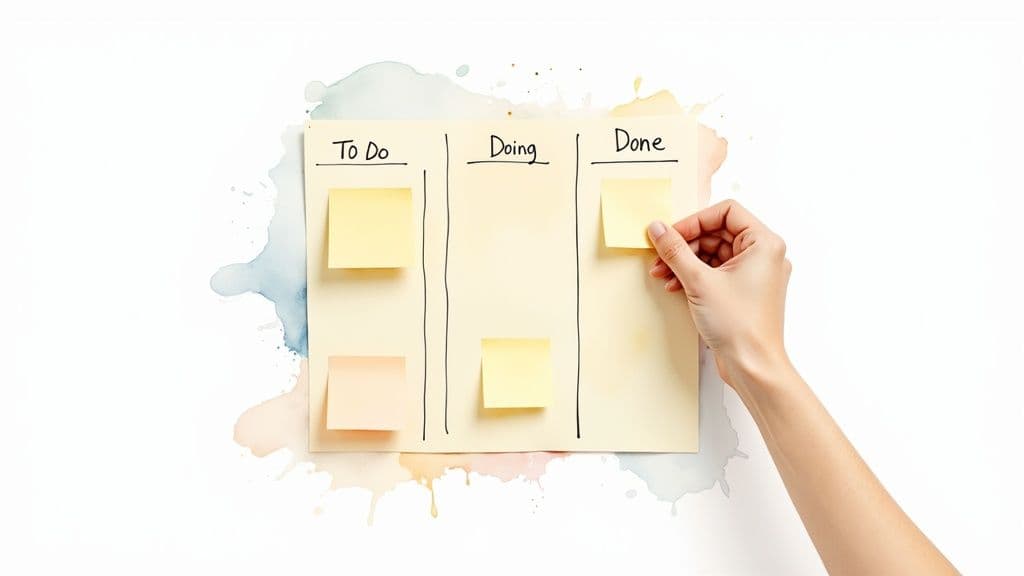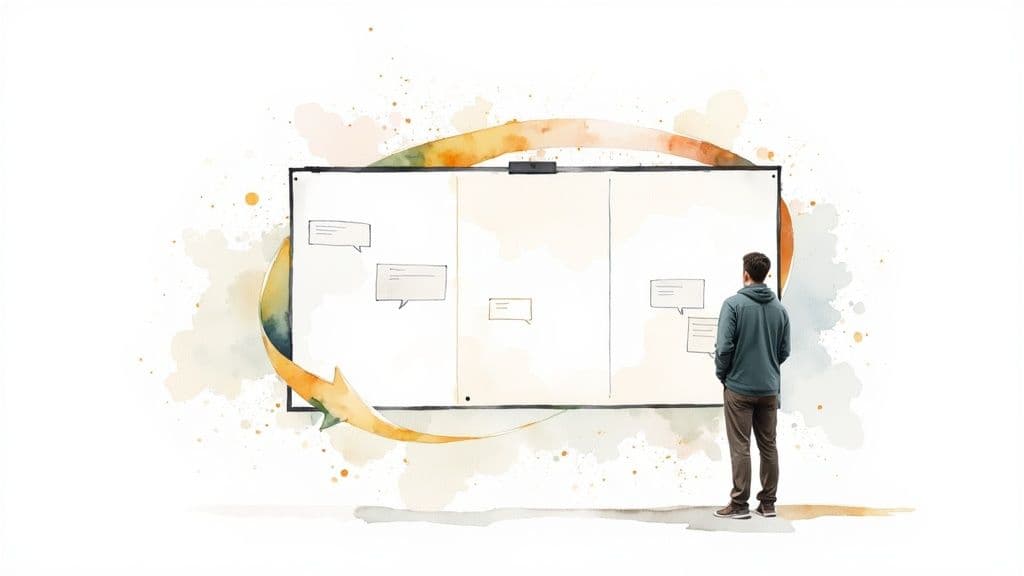Discover 8 essential Kanban best practices to maximize your team's efficiency. Learn to visualize workflows, limit WIP, and manage flow with Fluidwave.
July 8, 2025 (5mo ago)
8 Kanban Best Practices for Peak Workflow in 2025
Discover 8 essential Kanban best practices to maximize your team's efficiency. Learn to visualize workflows, limit WIP, and manage flow with Fluidwave.
← Back to blog
In today's fast-paced work environment, achieving a state of productive 'flow' is the ultimate goal. Yet, many teams struggle with invisible work, shifting priorities, and persistent bottlenecks that derail progress. Kanban offers a powerful, visual framework to combat this chaos, but simply putting up a board isn't enough. The true magic lies in applying proven principles that transform your workflow from a simple task list into a highly efficient value delivery system.
This comprehensive guide moves beyond theory to detail eight fundamental kanban best practices**. Each section provides actionable steps and practical examples to help you optimize your process, reduce waste, and achieve predictable, high-quality output. Forget generic advice; we are focused on tangible strategies that deliver immediate value.
You will learn how to visualize your entire workflow, effectively limit work in progress to prevent burnout, and establish clear policies that align your team. We will also explore how to manage flow and implement feedback loops for continuous improvement. Throughout this article, we'll show how modern tools like Fluidwave can amplify these practices, turning core concepts into tangible results and saving your team valuable hours each week. By mastering these strategies, you can move from chaos to clarity and supercharge your team's efficiency.
1. Start with What You Do Now
One of the most powerful and frequently overlooked Kanban best practices is to begin exactly where you are. Instead of overhauling your entire system, this foundational principle, championed by Kanban pioneer David J. Anderson, advocates for an evolutionary approach. You start by mapping your existing workflow, complete with its current roles, responsibilities, and processes, to gain a clear, honest understanding of how work currently flows.

This method respects your team's current reality and minimizes the resistance often associated with revolutionary change. By visualizing what is, you create a shared baseline for identifying inefficiencies and agreeing on incremental improvements. For instance, Spotify’s engineering culture famously integrated Kanban principles alongside existing Scrum frameworks, allowing teams to evolve their processes organically rather than forcing a disruptive, top-down mandate.
How to Implement This Practice
To apply this principle effectively, begin by documenting your workflow as it truly exists, not as you wish it existed.
- Interview Your Team: Talk to team members to understand the actual steps they take to move a task from initiation to completion. Document these stages honestly.
- Create an Initial Board: Use your findings to build your first Kanban board in Fluidwave. Start simple, perhaps with just "To Do," "In Progress," and "Done," and then add columns that reflect your team's unique stages like "Awaiting Review" or "Ready for Deployment."
- Identify Pain Points: With the workflow visualized, collaboratively identify the most significant bottlenecks and frustrations. Where does work get stuck? What causes delays? This initial map becomes your guide for targeted, gradual improvements.
This approach ensures that your Kanban implementation is grounded in reality, fostering buy-in and setting the stage for sustainable, continuous improvement.
2. Visualize the Workflow
Once you understand your current process, the next crucial Kanban best practice is to visualize it. This involves creating a shared, visible representation of your workflow, transforming abstract tasks and processes into a tangible system. By making work visible on a Kanban board, you create a single source of truth that allows everyone on the team to understand task status, identify bottlenecks, and see the flow of value from start to finish.

This practice is powerful because it externalizes knowledge work, making it explicit and manageable. For example, Zara’s fast-fashion design teams use visual boards to track garments from concept to production, enabling rapid decision-making. Similarly, software teams at Atlassian rely on Jira boards to visualize feature development, ensuring transparency and alignment across complex projects. The visual nature of the board fosters communication and collective ownership of the process.
How to Implement This Practice
Effectively visualizing your workflow requires more than just creating columns on a board. It's about accurately reflecting how work moves through your system.
- Map Your Stages: Define the distinct stages of your workflow and create a column for each on your Fluidwave board. Go beyond "To Do, In Progress, Done" by adding specific states like "Ready for Review," "Blocked," or "Awaiting Deployment" to mirror your actual process.
- Use Visual Cues: Enhance clarity with visual signals. Use different colors for different work types (e.g., red for bugs, blue for features), add team member avatars to show ownership, and use labels for priority. This makes the board scannable and instantly informative.
- Introduce Swimlanes: Organize your board further by using horizontal swimlanes to separate different projects, teams, or service classes. This is especially useful for teams managing multiple workstreams simultaneously, as it prevents the board from becoming cluttered and confusing.
By creating a clear and detailed visual model, you empower your team to manage their flow, spot issues proactively, and continuously refine their process. You can learn more about setting up an effective visual system by exploring how to use a Kanban board for project management.
3. Limit Work in Progress (WIP)
Limiting Work in Progress (WIP) is one of the most transformative Kanban best practices, directly addressing the hidden costs of multitasking. This principle involves setting explicit caps on the number of tasks allowed in each stage of your workflow. Instead of constantly starting new items, WIP limits force your team to focus on moving existing work through the system to completion, creating a smooth and predictable flow. It’s a shift from a "push" system, where work is assigned regardless of capacity, to a "pull" system, where new work is only pulled in when capacity becomes available.

This powerful concept, rooted in the Theory of Constraints and championed by Don Reinertsen, prevents system overload and exposes bottlenecks in real time. For example, Pixar Animation Studios famously limits the number of scenes in active production simultaneously. This focus ensures each scene receives the full creative attention required, improving quality and preventing artists from being stretched too thin across multiple complex shots. The result is a more efficient pipeline and a higher-caliber final product.
How to Implement This Practice
Applying WIP limits effectively requires careful observation and collaborative agreement, not arbitrary restrictions.
- Analyze and Set Initial Limits: First, examine your existing workflow to see how many items are typically in each stage. Set your initial WIP limits slightly below this current average to create a gentle pull. For instance, if your "In Review" column usually has 5 tasks, start with a limit of 4.
- Visualize Limits on Your Board: Make your WIP limits highly visible. In Fluidwave, you can configure columns to display the limit and the current item count (e.g., 3/4). This visual cue makes it immediately obvious when a stage is at capacity and prevents new work from being pushed into it.
- Adapt and Refine: WIP limits are not static. Regularly discuss their effectiveness in team meetings. If a limit is consistently causing a bottleneck or is too generous, adjust it. The goal is to find the sweet spot that maximizes flow and minimizes idle time, turning your Kanban board into a true pull system.
4. Make Process Policies Explicit
One of the most critical Kanban best practices is to make your process policies explicit. This means clearly documenting and communicating the rules that govern how work moves through your system. Without explicit policies, teams rely on implicit assumptions, leading to inconsistency, confusion, and rework. Explicit policies create a shared understanding of what "done" means for each stage, how to prioritize tasks, and what quality standards must be met.

This practice removes ambiguity and empowers team members to make autonomous, high-quality decisions. For example, software teams at Google define clear exit criteria for their "Code Review" column, specifying that at least two senior engineers must approve the changes before a task can move forward. This ensures quality and consistency without constant managerial oversight. Similarly, the BBC has explicit editorial workflow policies that guide a story from initial draft to publication, ensuring journalistic standards are upheld at every step.
How to Implement This Practice
Making policies explicit transforms your Kanban board from a simple task tracker into a powerful process management tool.
- Define Column Criteria: For each column on your Kanban board, collaboratively define its entry and exit criteria. What must be true for a card to move into a column? What does "done" look like for that stage? Post these definitions directly on the board, perhaps in the column header or as a linked document in Fluidwave.
- Establish a "Definition of Done": Create a clear, universal checklist for when a work item is considered fully complete. This policy might include passing all quality assurance tests, receiving client approval, and updating relevant documentation.
- Document Prioritization Rules: Clarify how the team should decide what to work on next. This could be based on a "first-in, first-out" system, a class of service (e.g., Expedite, Standard), or another business-driven logic. Make these rules visible to everyone.
By making policies explicit, you create a system that is transparent, fair, and geared toward predictable, high-quality output. It is a cornerstone of a mature Kanban implementation.
5. Manage Flow
One of the core Kanban best practices is to actively manage the flow of work. Rather than focusing on keeping individuals busy, the goal is to ensure work items move smoothly and predictably through your system from start to finish. This principle, heavily influenced by thinkers like Don Reinertsen and the pioneers of Lean manufacturing, shifts the focus from resource utilization to value delivery speed.
Managing flow means identifying and resolving bottlenecks, measuring cycle time, and making continuous adjustments to improve throughput. For example, Netflix’s content production teams use this to manage the flow of projects through various development phases, from script to screen, ensuring a predictable pipeline of new releases. Similarly, hospitals manage patient flow through treatment processes to reduce wait times and improve care outcomes.
How to Implement This Practice
Effectively managing flow requires a focus on metrics and a commitment to removing impediments.
- Visualize Work Item Age: Use features in Fluidwave to track how long each card has been in a particular column. This "work in process age" is a leading indicator of potential problems and helps you spot items that are getting stuck before they derail your schedule.
- Use Cumulative Flow Diagrams (CFDs): This chart is essential for managing flow. It visualizes your work in progress, cycle time, and throughput over time. Regularly reviewing your CFD helps you understand the health of your workflow and see the impact of any changes you make.
- Focus on Flow Metrics: Prioritize metrics like cycle time (how long it takes to complete a task) and throughput (how many tasks are completed per unit of time). These provide a clear picture of your system's efficiency. For a deeper dive into this, you can learn more about measuring team performance on the Fluidwave blog.
By actively managing flow, you create a more stable, predictable system that consistently delivers value to your customers.
6. Implement Feedback Loops
One of the most essential Kanban best practices is the deliberate implementation of feedback loops. These are regular, structured opportunities for the team to review process performance, work quality, and team dynamics. Rather than waiting for a crisis, this practice institutionalizes continuous improvement by creating consistent channels for gathering and acting on information. It is the engine that drives the evolution of your Kanban system from a simple task board into a highly refined workflow.
This principle transforms observation into action. For example, Toyota’s famed Production System relies heavily on frequent feedback, from "gemba walks" where managers observe the factory floor firsthand to kaizen events focused on rapid process improvement. Similarly, Spotify’s autonomous squads use regular retrospectives to inspect their way of working and experiment with improvements, ensuring their processes adapt to new challenges and learnings. These loops make the system responsive and resilient.
How to Implement This Practice
To build effective feedback mechanisms, you must integrate them directly into your team's regular rhythm.
- Schedule Cadenced Meetings: Establish a predictable schedule for key meetings. Daily stand-ups focus on short-term flow, while weekly or bi-weekly retrospectives allow for deeper reflection on the system itself. Service delivery reviews can analyze metrics and customer feedback.
- Use Data to Guide Discussions: In your Fluidwave board, leverage reports on cycle time, lead time, and throughput. Use these metrics as the factual basis for conversations, shifting the focus from individual performance to systemic bottlenecks and opportunities.
- Foster Psychological Safety: Create an environment where team members feel safe to provide honest, constructive feedback without fear of blame. The goal is to identify weaknesses in the process, not in people. Acting on feedback quickly is crucial for building and maintaining this trust.
7. Improve Collaboratively, Evolve Experimentally
Effective Kanban implementation is not a one-time setup but a continuous journey of refinement. This core practice, deeply rooted in the principles of Lean and the Toyota Production System's concept of kaizen, emphasizes that process improvement should be a shared, ongoing responsibility. Instead of top-down mandates, change is driven by the team through small, controlled experiments, a concept heavily influenced by Eric Ries's Lean Startup methodology.
This approach combines collaborative problem-solving with a scientific method to validate potential improvements. By treating changes as hypotheses to be tested, teams can make data-driven decisions, reduce the risk associated with large-scale overhauls, and foster a culture of ownership and innovation. For example, Amazon's famous "two-pizza teams" are small and autonomous enough to experiment with their own processes, leading to faster, more effective evolution without disrupting the entire organization.
How to Implement This Practice
Adopting an experimental mindset allows your team to evolve your workflow safely and effectively. This is one of the most powerful kanban best practices for achieving sustainable progress.
- Formulate a Hypothesis: When you identify a bottleneck, frame a potential solution as a testable hypothesis. For example, "We believe that adding a dedicated 'Peer Review' column and limiting it to two items will reduce our overall cycle time by 10%."
- Run Small, Reversible Experiments: Start with changes that are low-risk and easy to undo. Set a specific time frame for the experiment, such as two weeks or one full sprint. This minimizes disruption if the change doesn't produce the desired outcome.
- Measure and Analyze Results: Before starting, define what success looks like with clear metrics. After the experiment, use the data from your Fluidwave board, like cycle time or throughput charts, to transparently review the results with the entire team. This objective analysis helps determine whether to adopt, adapt, or abandon the change.
By embracing this cycle of collaborative improvement and experimentation, your team can steadily enhance its productivity and efficiency in a way that feels empowering and organic.
8. Focus on Customer Value
A highly effective Kanban system does more than just move tasks across a board; it ensures that every single task contributes directly to what the customer values. This Kanban best practice involves orienting your entire workflow, from prioritization to completion, around the ultimate goal of customer satisfaction. Inspired by lean principles and customer development methodologies, this approach shifts the focus from internal outputs (like features shipped) to external outcomes (like improved customer retention or satisfaction).
This principle transforms your Kanban board from a simple task manager into a powerful value delivery engine. By constantly asking, "Does this work matter to our customer?" you ensure that your team's limited time and resources are invested in activities that generate the most significant impact. For example, Amazon’s famous "customer obsession" is a real-world application of this, where every process, including their fulfillment workflow, is relentlessly optimized to enhance the customer's experience and delivery speed.
How to Implement This Practice
To embed a customer-centric focus into your Kanban process, you need to make value a visible and measurable component of your workflow.
- Define Value Collaboratively: Work with stakeholders, product owners, and customer-facing teams to create a clear, shared definition of what "value" means for your customers. Is it speed, quality, a specific feature, or cost savings?
- Map the Full Value Stream: Go beyond your team's internal process. Map the entire journey from the initial customer request or idea all the way to the delivery of the solution. Use a tool like Fluidwave to visualize this end-to-end flow, identifying where value is added and where delays occur.
- Prioritize with Customer Outcomes: When prioritizing your backlog, rank items based on their potential impact on customer outcomes, not just on internal urgency or complexity. Use techniques like customer journey mapping to identify the most critical pain points to solve.
- Measure and Validate: Implement metrics that track value delivery, such as customer satisfaction scores (CSAT), Net Promoter Score (NPS), or lead time from a customer perspective. Regularly engage with customers to validate that your recent work has genuinely solved their problems and delivered the expected value.
Kanban Best Practices Comparison Table
| Practice | Implementation Complexity 🔄 | Resource Requirements ⚡ | Expected Outcomes 📊 | Ideal Use Cases 💡 | Key Advantages ⭐ |
|---|---|---|---|---|---|
| Start with What You Do Now | Low to Moderate 🔄, focuses on existing processes | Low ⚡, leverages current team knowledge | Gradual improvement, reduced disruption 📊 | Teams seeking smooth adoption and evolutionary change | Minimizes resistance, faster adoption, low risk ⭐ |
| Visualize the Workflow | Moderate 🔄, requires setup and upkeep of boards | Moderate ⚡, requires tools or physical boards | Increased transparency, bottleneck visibility 📊 | Any team needing clear process visualization | Enhances communication, enables data-driven decisions ⭐ |
| Limit Work in Progress (WIP) | Moderate 🔄, needs discipline to enforce | Low to Moderate ⚡, mostly policy enforcement | Reduced multitasking, faster delivery 📊 | Teams facing overload and multitasking challenges | Improves focus, exposes bottlenecks quickly ⭐ |
| Make Process Policies Explicit | Moderate to High 🔄, requires documentation and updates | Low to Moderate ⚡, effort in defining policies | Consistency, reduced ambiguity, better onboarding 📊 | Complex workflows needing clear, shared rules | Increases predictability, reduces confusion ⭐ |
| Manage Flow | High 🔄, involves continuous monitoring and analysis | Moderate to High ⚡, may require specialized tools | Improved throughput, cycle time reduction 📊 | Teams focused on optimizing delivery and capacity planning | Enhances predictability, identifies improvements ⭐ |
| Implement Feedback Loops | Moderate 🔄, requires regular meetings and facilitation | Moderate ⚡, time investment for cadences | Continuous improvement, increased engagement 📊 | Teams aiming for ongoing learning and adaptive processes | Promotes rapid problem solving, builds learning culture ⭐ |
| Improve Collaboratively, Evolve Experimentally | High 🔄, needs disciplined experimentation and analysis | Moderate to High ⚡, requires time and skills | Reduced risk in changes, sustainable improvements 📊 | Teams adopting scientific and collaborative improvement | Builds ownership, drives evidence-based change ⭐ |
| Focus on Customer Value | Moderate 🔄, involves customer collaboration and alignment | Moderate ⚡, requires continuous validation | Higher customer satisfaction, aligned priorities 📊 | Organizations prioritizing customer-centric outcomes | Drives meaningful improvements, aligns with business goals ⭐ |
Evolve Your Workflow, Master Your Flow
You've now explored the foundational pillars of a high-performing Kanban system. Moving from a simple to-do list to a dynamic, visual workflow is a transformative journey, not a final destination. The eight core Kanban best practices we've detailed provide more than just a set of rules; they offer a comprehensive framework for achieving sustainable productivity and predictable delivery.
This journey begins with the simple but profound act of starting with what you do now, respecting your current processes while creating a launchpad for change. From there, you build a transparent system by visualizing the workflow and introducing the critical discipline of limiting Work in Progress (WIP). These initial steps alone can dramatically reduce chaos and reveal hidden bottlenecks.
From Practice to Mastery
True mastery, however, lies in the continuous application of the more advanced principles. Making your process policies explicit ensures everyone on your team operates with shared understanding and consistency. Actively managing flow transforms you from a reactive task-doer into a proactive system optimizer, focusing on the smooth, predictable movement of value from start to finish.
This evolution is fueled by a commitment to constant learning and adaptation. By implementing feedback loops at every level and embracing a culture where you improve collaboratively and evolve experimentally, you build a resilient, anti-fragile system. Your team learns to adapt not just to problems but to opportunities, using data and direct experience to guide their next steps. This is the essence of a mature Kanban implementation.
Ultimately, all these practices serve a single, unifying purpose: delivering maximum customer value. A finely tuned Kanban system ensures that every ounce of effort is directed toward what matters most to the end user. It aligns your team’s daily actions with strategic goals, making your workflow a powerful engine for customer satisfaction and business growth. Adopting these Kanban best practices is an investment in clarity, efficiency, and a culture of continuous improvement.
Ready to put these principles into action with a tool built for seamless flow? Fluidwave combines a powerful Kanban view with AI-powered prioritization and on-demand virtual assistants, giving you the ultimate platform to visualize, manage, and optimize your workflow. Start mastering your flow with Fluidwave today.
Focus on What Matters.
Experience lightning-fast task management with AI-powered workflows. Our automation helps busy professionals save 4+ hours weekly.